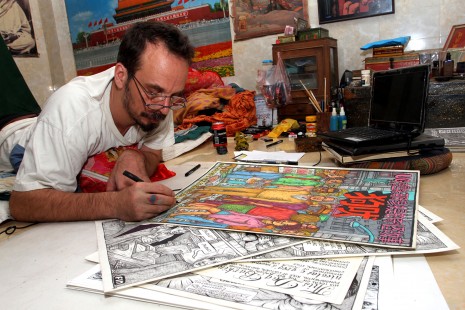The story behind the intricately drawn images that will go on exhibit at Java Cafe last week began a decade ago in England where Nicolas Grey was an illustrator working on graphic novels.

As he became interested in cult leaders, he came across a strange figure who had developed a following in spite of himself: an Indian anti-guru philosopher by the name of U.G. Krishnamurti, who was fond of telling people not to listen to him.
“He was kind of famous for destroying any concept or thought that you had…. He’d undermined everything that you thought or believed in,” Mr. Grey said.
Mr. Grey soon began illustrating a novel on the man, and asked a friend of his, James Farley, to write the text. Plans were made for Mr. Grey to draw pages of the graphic novels in his favorite pen-and-ink style and for Mr. Farley—a social worker by profession with an English literature degree from Oxford University—to condense Mr. Krishnamurti’s life story and philosophy into a short text. Since there had been books written about Mr. Krishnamurti already, the two Englishmen did not expect their graphic novel to take long.
“We started to do our own research into it and it became a lot more complicated,” Mr. Grey said.
“A lot of the information in the books was wrong,” he said. “U.G. Krishnamurti was fond of telling stories of his life. But they were not consistent, and it’s very difficult to tease the truth out of the tales he told.”
Mr. Grey went to India where he researched the man and then moved to Phnom Penh in 2007, still working on the book. A few years later, Mr. Farley relocated to Siem Reap City and, after a long process during which 50 pages representing months of work were discarded as the duo uncovered new facts about Mr. Krishnamurti, the graphic novel “This Dog Barking – The Strange Story of UG Krishnamurti” was completed on July 1.
“I finished the book by finishing the first page on Monday,” Mr. Grey said.
The 140-page novel, which took more than three years of full-time work to draw, will be published in England toward the end of the year, he said.
The exhibition at Java cafe will include pages that did not make it into the book but will be part of a related comic book that Mr. Grey plans to release.
Every page he has drawn is an illustration made of infinite details that create a rich tapestry so harmonious that it fills the eye without overwhelming. The text on each page is part of the design, at times a sentence incorporated into an image, and sometimes a few lines of text in a box on the page.
Condensing the life story and philosophy of Mr. Krishnamurti into a short text was a challenge to say the least, Mr. Farley said. Beside the fact that his life story was convoluted, his nihilist philosophy is not easy to explain in a few lines, he noted.
“He frequently advised people not to listen to him, that the ideas he was bringing up would do people no good and would act as a kind of virus on them,” Mr. Farley said.
“The idea of the body was very important to him,” he said. Mr. Krishnamurti believed that anything about a person’s identity or soul was a social product and that only the physical processes including the body decomposing and nourishing the soil after death were real, he said.
“Mr. Krishnamurti just traveled around the world. He’d show up in a city, maybe in California or in Switzerland, France or India” Mr. Farley said. As word spread that he was in town, people would gather to listen to him. “And he would just talk from morning till night. The guy spoke like 18 hours a day: He never stopped talking.”
The authors received tapes of Mr. Krishnamurti’s talks from his friends. “At one point we had a poorly-recorded conversation recorded in Amsterdam sometimes in the ’80s,” Mr. Farley said. “I had to keep listening over and over again to the tape…. It took a week and I ended up with maybe 70 words.”
As the authors mention in the book, Mr. Krishnamurti passed away in 2007 at 89 years old. His will read: “I have lived my life as though each day was my last, shedding properties that are not needed.” It is against his will that records of his thoughts were kept by his followers, Mr. Grey said.
While the book may not appeal to the general public, Mr. Farley believes that it will attract people interested in philosophy and spiritual matters, as well as those who enjoy the works of science fiction writer Philip K. Dick.
The exhibition at Java cafe will run through August.